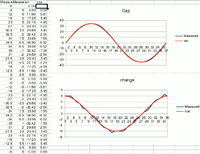Hi Jack3.142
I'm an astronomer and wanted to comment a little on some of things you said:
Thanks cubist.
What's interesting as I currently understand it is that the earth does not wobble into and away from the sun as each year progresses to get winter and summer. It's tilt in respect of everything in the universe is constant.
The tilt of the Earth's rotation axis with respect to its orbital plane (the ecliptic plane) is fairly constant. But the axis does change direction (with constant tilt, so that it sweeps out a cone every 26,000 years). This motion is called
precession. Because of precession, the direction of the axis isn't constant with respect to "everything [else] in the universe." The axis changes direction with respect to the "fixed" (very distant and nearly unmoving) stars. There is also a tiny bit of wobble called '
nutation' that changes the angle of the axis a little bit. See the diagram at the top of this page:

en.wikipedia.org
What causes winter and summer is the orbit of the earth around the sun, because on one "side" of the orbit the tilt puts the northern hemisphere more in the sun, and on the other side of the orbit that same tilt puts the southern hemisphere more in the sun.
What causes the seasons is the tilt, in the sense that the tilt leads to longer (or shorter) hours of sunlight, and the sunlight that is received being more direct (or more oblique). Yes it is true that orbital motion is required in order for the tilt of a given hemisphere to change from being "away from" to being "towards" the sun. But it's not like it's possible for orbital motion
not to happen, and orbital motion with
no tilt would result in
no seasonal changes.
Yes, the transition from a hemisphere being tilted away from the sun to being tilted towards it is gradual and continuous, not abrupt.
From our perspective, on Earth, what really changes over the course of a year is the Sun's coordinates on the Celestial sphere. As you seem to already know, these coordinates are measured in terms of a celestial longitude (Right Ascension) and a celestial latitude (Declination). The exercise of figuring out where the sun will be on a given date in local "horizon" coordinates (azimuth and elevation) is then an exercise in transforming between two different spherical coordinate systems: from RA and Dec to Az and El. To do this, you also need to know your latitude, because this tells you the angular offset between the poles of the two coordinate systems. Finally, you must know the
hour angle of the object (how far away it is in RA from your meridian), which depends not only on the object's RA, but also on the local sidereal time. Once you have all of these inputs, the calculation is an exercise in spherical trigonometry. Here is a link to website that explains the math:
I hope that this is somewhat helpful.




